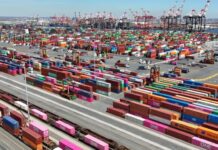
The Port of Kiel has launched a three-step plan that puts the port’s ‘Blue Port’ concept into concrete terms, as a framework of its effort to completely reduce all of its carbon dioxide (CO2) emissions by 2030.
“The port will be climate-neutral by the end of this decade,” noted Dr. Dirk Claus, Managing Director of Port of Kiel.
The port’s three-step plan envisages covering 60% of the energy requirements of ships calling at Kiel with green electricity as early as next year, according to a statement.
This figure is expected to reach 80-90% by 2025, before climate neutrality is achieved for all activities of the German port in 2030, through a range of measures to supply port facilities with 100% climate-neutral green electricity that have already been implemented.
The port is also planning to further decrease nitrogen oxides emissions.
According to an environmental report, the Port of Kiel already avoided more than 6,200 tonnes of CO2 in 2020, while almost 18,800 tonnes were still emitted.
The energy demand at the terminals has already been sustainably reduced by switching to economical LED technology and increasing energy efficiency, while photovoltaic systems provide around 290,000-kilowatt hours of solar energy every year, according to a statement.
The port in the Baltic is also gradually converting its own vehicle fleet to electric drive and offers incentives to customers to promote the decarbonisation process.
Moreover, the port has invested in on-shore power to reduce emissions. After the first system for shore-side power supply was connected to Norwegenkai in 2019, a second larger one was commissioned at Ostseekai in June, earlier this year.
In the meantime, the Federal Ministry of Transport and Digital Infrastructure (BMVI) is funding the establishment of a digital test field in the port to make the processes at the freight terminals even more efficient.
Operational processes will therefore be optimised and made more sustainable on the basis of a 5G campus network. In this way, climate-neutral growth in port handling is expected to be supported by innovative information technology (IT).
Measures towards zero emissions by 2030 in the German port also include electrification of the vehicle fleet, such as industrial trucks, digitalisation of operational processes for increased efficiency, as well as tariff-based environmental discount as an incentive for climate-friendly transformation.







